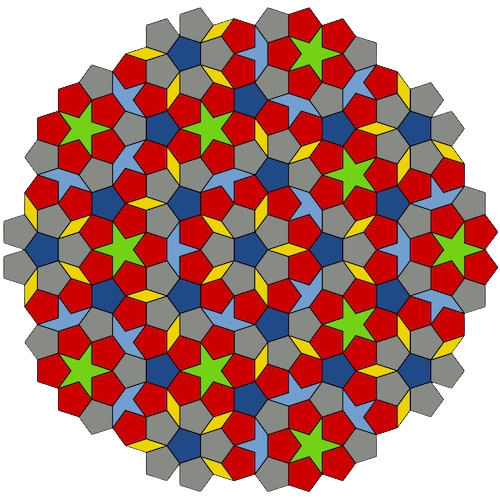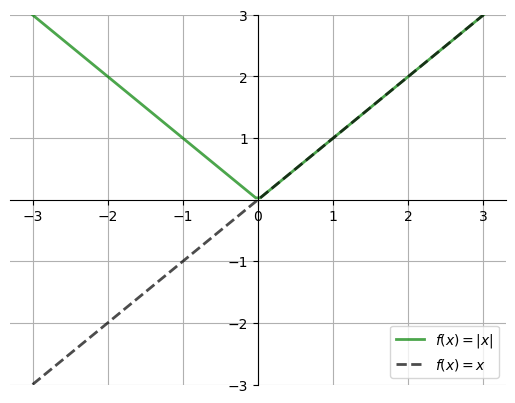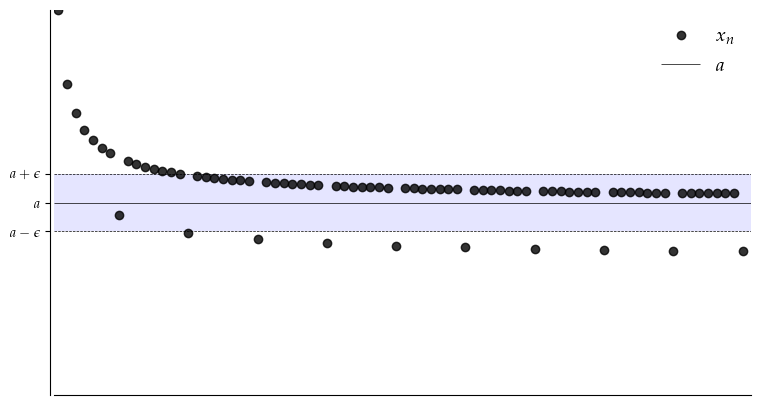Basics of real analysis#
ECON2125/6012 Lecture 4
Fedor Iskhakov
Announcements & Reminders
The first test is due before the next lecture!
The test will be published tomorrow (before midnight on Friday)
The test will include multiple choice questions (where multiple options can be correct), True/False questions and open response questions where you may need to upload a file
Please, find the practice test on Wattle and make sure you are comfortable with the setup, including uploading an image/pdf file
Tests are timed: practice paying attention to the countdown timer
The deadline for submission of the first test is midnight on Wednesday, August 23
I am traveling next week, no face-to-face lecture on August 24!
Plan for this lecture
Continuing with revision of fundamental concepts and ideas
Sequences
Convergence and limits
Differentiation, Taylor series
Analysis in \(\mathbb{R}^n\)
Open and closed sets
Continuity of functions
Mainly review of key ideas
Supplementary reading:
Simon & Blume: 12.1, 12.2, 12.3, 12.4, 12.5 10.1, 10.2, 10.3, 10.4, 13.4
Sundaram: 1.1.1, 1.1.2, 1.2.1, 1.2.2, 1.2.3, 1.2.7, 1.2.8, 1.4.1
Analysis in \(\mathbb{R}\)#
Example
Let \(F(x)\) be a profit function, so for solving profit maximization we have to solve \(f(x)=0\) where \(f(x)=F'(x)\).
Or: we want to solve an equation \(g(x) = y\) for \(x\), equivalently \(f(x) = g(x) - y\)
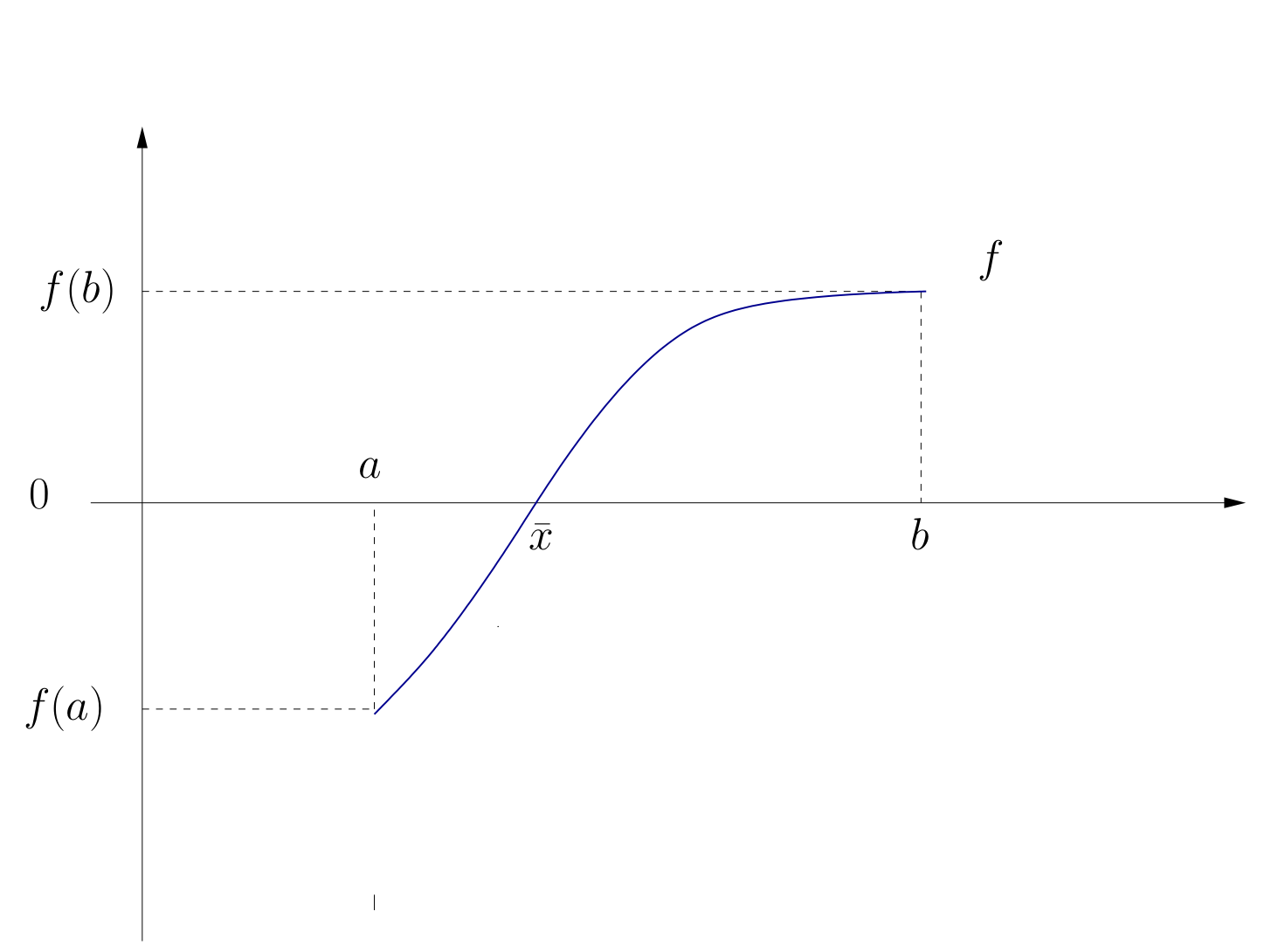
Fig. 31 Existence of a root#
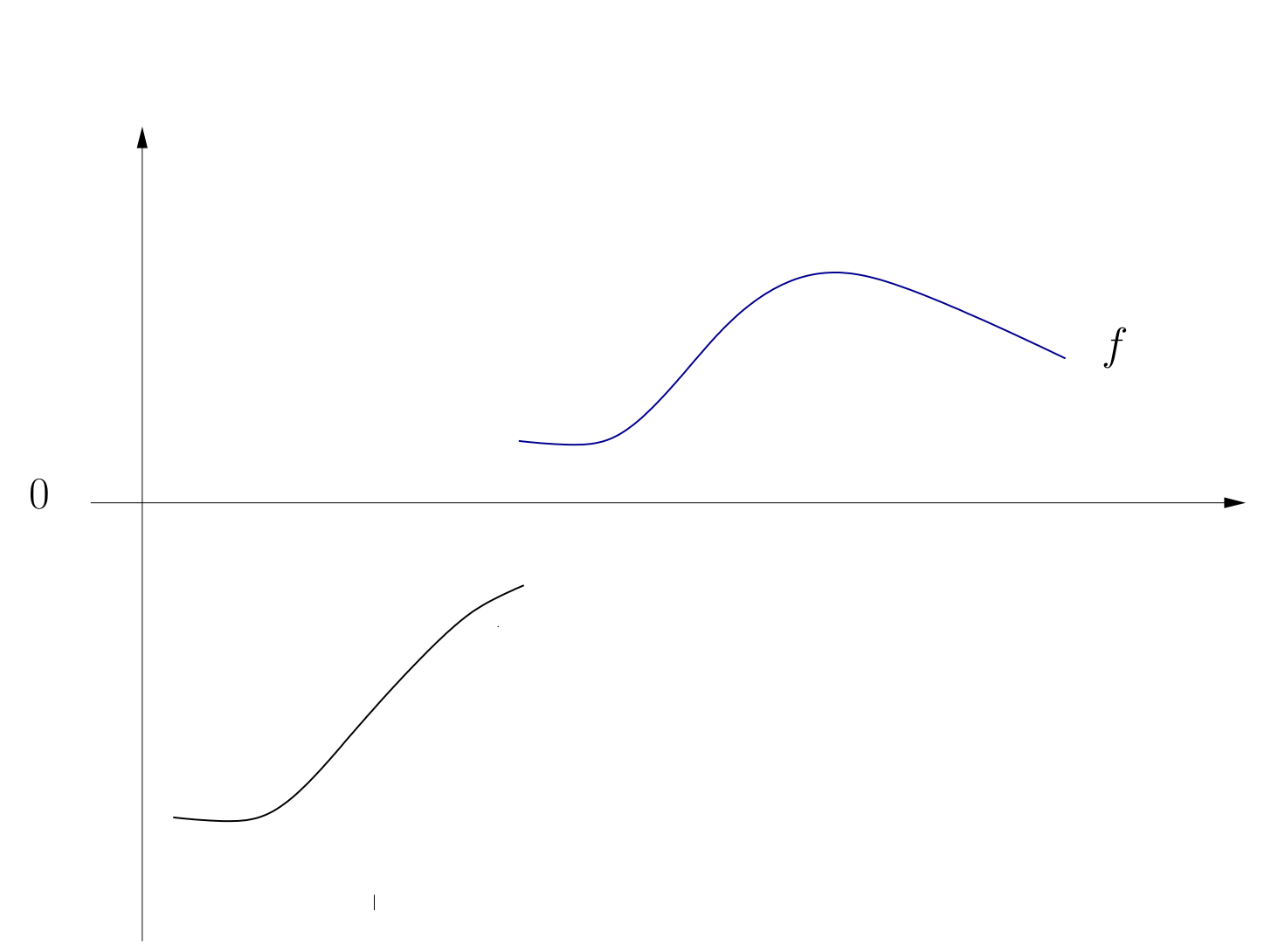
Fig. 32 Non-existence of a root#
One answer: a solution exists under certain conditions including continuity.
Questions:
So how can I tell if \(f\) is continuous?
Can we weaken the continuity assumption?
Does this work in multiple dimensions?
When is the root unique?
How can we compute it?
These are typical problems in analysis
Bounded sets#
Definition
The absolute value of \(x \in \mathbb{R}\) denoted \(|x|\) is \(|x| := \max\{x, -x\}\).
Show code cell source
import numpy as np
import matplotlib.pyplot as plt
def subplots():
"Custom subplots with axes throught the origin"
fig, ax = plt.subplots()
# Set the axes through the origin
for spine in ['left', 'bottom']:
ax.spines[spine].set_position('zero')
for spine in ['right', 'top']:
ax.spines[spine].set_color('none')
ax.grid()
return fig, ax
fig, ax = subplots()
ax.set_ylim(-3, 3)
ax.set_yticks((-3, -2, -1, 1, 2, 3))
x = np.linspace(-3, 3, 100)
ax.plot(x, np.abs(x), 'g-', lw=2, alpha=0.7, label=r'$f(x) = |x|$')
ax.plot(x, x, 'k--', lw=2, alpha=0.7, label=r'$f(x) = x$')
ax.legend(loc='lower right')
plt.show()
Fact
For any \(x, y \in \mathbb{R}\), the following statements hold
\(|x| \leq y\) if and only if \(-y \leq x \leq y\)
\(|x| < y\) if and only if \(-y < x < y\)
\(|x| = 0\) if and only if \(x=0\)
\(|xy| = |x| |y|\)
\(|x+y| \leq |x| + |y|\)
Last inequality is called the triangle inequality
Using these rules, let’s show that if \(x, y, z \in \mathbb{R}\), then
\(|x-y| \leq |x| + |y|\)
\(|x-y| \leq |x - z| + |z - y|\)
Proof
Hint: \(x-y = x-z+z-y\)
Definition
\(A \subset \mathbb{R}\) is called bounded if \(\exists \; M \in \mathbb{R}\) s.t. \(|x| \leq M\), all \(x \in A\)

Example
Every finite subset \(A\) of \(\mathbb{R}\) is bounded
Set \(M := \max \{ |a| : a \in A \}\)
Example
\(\mathbb{N}\) is unbounded
For any \(M \in \mathbb{R}\) there is an \(n\) that exceeds it
Example
\((a, b)\) is bounded for any \(a\) and \(b\)
Proof
We have to show that each \(x \in (a, b)\) satisfies \(|x| \leq M := \max\{ |a|, |b| \}\)
Cases:
\(0 \le a \le b \implies x > 0, x = |x| < |b| = b = \max\{|a|,|b|\}\)
\(a \le b \le 0 \implies a < x < 0, |x|= -x < -a = |a| = \max\{|a|,|b|\}\)
\(a \le 0 \le b \implies\)
Fact
If \(A\) and \(B\) are bounded sets then so is \(A \cup B\)
Proof
Let \(A\) and \(B\) be bounded sets and let \(C := A \cup B\)
By definition, \(\exists \, M_A\) and \(M_B\) with
Let \(M_C := \max\{M_A , M_B\}\) and fix any \(x \in C\)
Epsilon-balls (\(\epsilon\)-balls)#
Definition
Given \(\epsilon > 0\) and \(a \in \mathbb{R}\), the \(\epsilon\)-ball around \(a\) is
Equivalently,

Exercise: Check equivalence
Fact
If \(x\) is in every \(\epsilon\)-ball around \(a\) then \(x=a\)
Proof
Suppose to the contrary that
\(x\) is in every \(\epsilon\)-ball around \(a\) and yet \(x \ne a\)
Since \(x\) is not \(a\) we must have \(|x-a| > 0\)
Set \(\epsilon := |x-a|\)
Since \(\epsilon > 0\), we have \(x \in B_{\epsilon}(a)\)
This means that \(|x-a| < \epsilon\)
That is, \(|x - a| < |x - a|\)
Contradiction!
Fact
If \(a \ne b\), then \(\exists \; \epsilon > 0\) such that \(B_{\epsilon}(a)\) and \(B_{\epsilon}(b)\) are disjoint.

Proof
Let \(a, b \in \mathbb{R}\) with \(a \ne b\)
If we set \(\epsilon := |a-b|/2\), then \(B_{\epsilon}(a)\) and \(B_\epsilon(b)\) are disjoint
To see this, suppose to the contrary that \(\exists \, x \in B_{\epsilon}(a) \cap B_\epsilon(B)\)
Then \( |x - a| < |a -b|/2\) and \(|x - b| < |a -b|/2\)
But then
Contradiction!
Sequences#
Definition
A sequence is a function from \(\mathbb{N}\) to \(\mathbb{R}\)
To each \(n \in \mathbb{N}\) we associate one \(x_n \in \mathbb{R}\)
Typically written as \(\{x_n\}_{n=1}^{\infty}\) or \(\{x_n\}\) or \(\{x_1, x_2, x_3, \ldots\}\)
Example
\(\{x_n\} = \{2, 4, 6, \ldots \}\)
\(\{x_n\} = \{1, 1/2, 1/4, \ldots \}\)
\(\{x_n\} = \{1, -1, 1, -1, \ldots \}\)
\(\{x_n\} = \{0, 0, 0, \ldots \}\)
Definition
Sequence \(\{x_n\}\) is called
bounded if \(\{x_1, x_2, \ldots\}\) is a bounded set
monotone increasing if \(x_{n+1} \geq x_n\) for all \(n\)
monotone decreasing if \(x_{n+1} \leq x_n\) for all \(n\)
monotone if it is either monotone increasing or monotone decreasing
Example
\(x_n = 1/n\) is monotone decreasing, bounded
\(x_n = (-1)^n\) is not monotone but is bounded
\(x_n = 2n\) is monotone increasing but not bounded
Convergence#
Let \(a \in \mathbb{R}\) and let \(\{x_n\}\) be a sequence
Suppose, for any \(\epsilon > 0\), we can find an \(N \in \mathbb{N}\) such that
Then \(\{x_n\}\) is said to converge to \(a\)
Convergence to \(a\) in symbols,
The sequence \(\{x_n\}\) is eventually in this \(\epsilon\)-ball around \(a\)
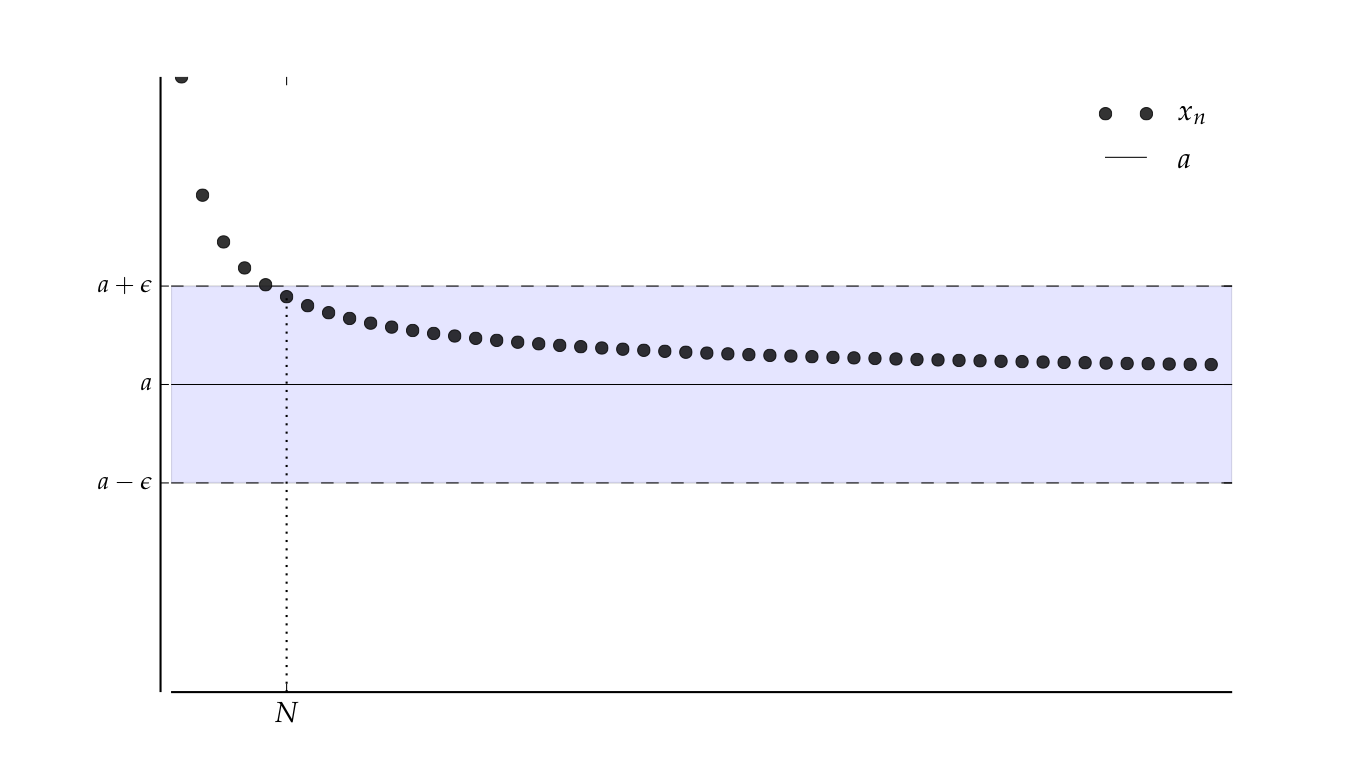
…and this one

…and this one

…and this one

Definition
The point \(a\) is called the limit of the sequence, denoted
if
We call \(\{ x_n \}\) convergent if it converges to some limit in \(\mathbb{R}\)
Example
\(\{x_n\}\) defined by \(x_n = 1 + 1/n\) converges to \(1\):
To prove this must show that \(\forall \, \epsilon > 0\), there is an \(N \in \mathbb{N}\) such that
To show this formally we need to come up with an “algorithm”
You give me any \(\epsilon > 0\)
I respond with an \(N\) such that equation above holds
In general, as \(\epsilon\) shrinks, \(N\) will have to grow
Proof
Here’s how to do this for the case \(1 + 1/n\) converges to \(1\)
First pick an arbitrary \(\epsilon > 0\)
Now we have to come up with an \(N\) such that
Let \(N\) be the first integer greater than \( 1/\epsilon\)
Then
Remark: Any \(N' > N\) would also work
Example
The sequence \(x_n = 2^{-n}\) converges to \(0\) as \(n \to \infty\)
Proof
Must show that, \(\forall \, \epsilon > 0\), \(\exists \, N \in \mathbb{N}\) such that
So pick any \(\epsilon > 0\), and observe that
Hence we take \(N\) to be the first integer greater than \(- \ln \epsilon / \ln 2\)
Then
What if we want to show that \(x_n \to a\) fails?
To show convergence fails we need to show the negation of
Negation: there is an \(\epsilon > 0\) where we can’t find any such \(N\)
More specifically, \(\exists \, \epsilon > 0\) such that, which ever \(N \in \mathbb{N}\) we look at, there’s an \(n \geq N\) with \(x_n\) outside \(B_{\epsilon}(a)\)
One way to say this: there exists a \(B_\epsilon(a)\) such that \(x_n \notin B_\epsilon(a)\) again and again as \(n \to \infty\).
This is the kind of picture we’re thinking of
Show code cell source
from __future__ import division
import matplotlib.pyplot as plt
import numpy as np
from matplotlib import rc
rc('font',**{'family':'serif','serif':['Palatino']})
rc('text', usetex=True)
N = 80
epsilon = 0.15
a = 1
def x(n):
return 1 + 1/(n**(0.7)) - 0.3 * (n % 8 == 0)
def subplots(fs):
"Custom subplots with axes throught the origin"
fig, ax = plt.subplots(figsize=fs)
# Set the axes through the origin
for spine in ['left', 'bottom']:
ax.spines[spine].set_position('zero')
for spine in ['right', 'top']:
ax.spines[spine].set_color('none')
return fig, ax
fig, ax = subplots((9, 5))
xmin, xmax = 0.5, N+1
ax.set_xlim(xmin, xmax)
ax.set_ylim(0, 2)
n = np.arange(1, N+1)
ax.set_xticks([])
ax.plot(n, x(n), 'ko', label=r'$x_n$', alpha=0.8)
ax.hlines(a, xmin, xmax, color='k', lw=0.5, label='$a$')
ax.hlines([a - epsilon, a + epsilon], xmin, xmax, color='k', lw=0.5, linestyles='dashed')
ax.fill_between((xmin, xmax), a - epsilon, a + epsilon, facecolor='blue', alpha=0.1)
ax.set_yticks((a - epsilon, a, a + epsilon))
ax.set_yticklabels((r'$a - \epsilon$', r'$a$', r'$a + \epsilon$'))
ax.legend(loc='upper right', frameon=False, fontsize=14)
plt.show()
Example
The sequence \(x_n = (-1)^n\) does not converge to any \(a \in \mathbb{R}\)
Proof
This is what we want to show
Since it’s a “there exists”, we need to come up with such an \(\epsilon\)
Let’s try \(\epsilon = 0.5\), so that
We have:
If \(n\) is odd then \(x_n = -1\) when \(n > N\) for any \(N\).
If \(n\) is even then \(x_n = 1\) when \(n > N\) for any \(N\).
Therefore even if \(a=1\) or \(a=-1\), \(\{x_n\}\) not in \(B_\epsilon(a)\) infinitely many times as \(n \to \infty\). It holds for all other values of \(a \in \mathbb{R}\).
Properties of Limits#
Fact
Let \(\{x_n\}\) be a sequence in \(\mathbb{R}\) and let \(a \in \mathbb{R}\). Then as \(n \to \infty\)
Proof
Compare the definitions:
\(x_n \to a\) \(\iff\) \(\forall \, \epsilon > 0\), \(\exists \, N \in \mathbb{N}\) s.t. \(|x_n - a| < \epsilon\)
\(|x_n - a| \to 0\) \(\iff\) \(\forall \, \epsilon > 0\), \(\exists \, N \in \mathbb{N}\) s.t. \(||x_n - a| - 0| < \epsilon\)
Clearly these statements are equivalent
Fact
Each sequence in \(\mathbb{R}\) has at most one limit
Proof
Suppose instead that \(x_n \to a \text{ and } x_n \to b \text{ with } a \ne b \)
Take disjoint \(\epsilon\)-balls around \(a\) and \(b\)

Since \(x_n \to a\) and \(x_n \to b\),
\(\exists \; N_a\) s.t. \(n \geq N_a \implies x_n \in B_{\epsilon}(a)\)
\(\exists \; N_b\) s.t. \(n \geq N_b \implies x_n \in B_{\epsilon}(b)\)
But then \(n \geq \max\{N_a, N_b\} \implies \) \(x_n \in B_{\epsilon}(a)\) and \(x_n \in B_{\epsilon}(b)\)
Contradiction, as the balls are assumed disjoint
Fact
Every convergent sequence is bounded
Proof
Let \(\{x_n\}\) be convergent with \(x_n \to a\)
Fix any \(\epsilon > 0\) and choose \(N\) s.t. \(x_n \in B_{\epsilon}(a)\) when \(n \geq N\)
Regarded as sets,
Both of these sets are bounded
First because finite sets are bounded
Second because \(B_{\epsilon}(a)\) is bounded
Further, finite unions of bounded sets are bounded
Operations with limits#
Here are some basic tools for working with limits
Fact
If \(x_n \to x\) and \(y_n \to y\), then
\(x_n + y_n \to x + y\)
\(x_n y_n \to x y\)
\(x_n /y_n \to x / y\) when \(y_n\) and \(y\) are \(\ne 0\)
\(x_n \leq y_n\) for all \(n \implies x \leq y\)
Let’s check that \(x_n \to x\) and \(y_n \to y\) implies \(x_n + y_n \to x + y\)
Proof
Fix \(\epsilon > 0\)
Need to find \(N \in \mathbb{N}\) such that
Note that
\(|(x_n + y_n) - (x + y)| \leq |x_n - x| + |y_n - y|\) by triangle inequality
\(\exists N_x \in \mathbb{N}\) such that \(n \geq N_x \implies |x_n - x| < \epsilon/2\) by definition of the limit
\(\exists N_y \in \mathbb{N}\) such that \(n \geq N_y \implies |y_n - y| < \epsilon/2\) by definition of the limit as well
Take \(N := \max\{N_x, N_y\}\)
Combining the inequalities above concludes the proof.
Let’s also check the claim that \(x_n \to x\), \(y_n \to y\) and \(x_n \leq y_n\) for all \(n \in \mathbb{N}\) implies \(x \leq y\)
Proof
Suppose instead that \(x > y\)
Take disjoint \(\epsilon\)-balls \(B_\epsilon(x)\) and \(B_\epsilon(y)\) around these points

There exists an \(n\) such that \(x_n \in B_\epsilon(x)\) and \(y_n \in B_\epsilon(y)\)
But then \(x_n > y_n\), a contradiction
In words: “Weak inequalities are preserved under limits”
Here’s another property of limits, called the “squeeze theorem”
Fact
Let \(\{x_n\}\) \(\{y_n\}\) and \(\{z_n\}\) be sequences in \(\mathbb{R}\). If
\(x_n \leq y_n \leq z_n\) for all \(n \in \mathbb{N}\)
\(x_n \to a\) and \(z_n \to a\)
then \(y_n \to a\) also holds
Proof
Pick any \(\epsilon > 0\)
We can choose an
\(N_x \in \mathbb{N}\) such that \(n \geq N_x \implies x_n \in B_\epsilon(a)\)
\(N_z \in \mathbb{N}\) such that \(n \geq N_z \implies z_n \in B_\epsilon(a)\)
Exercise: Show that \(n \geq \max\{N_x, N_z\} \implies y_n \in B_\epsilon(a)\)
Infinite Sums#
Definition
Let \(\{x_n\}\) be a sequence in \(\mathbb{R}\)
Then the infinite sum of \(\sum_{n=1}^{\infty} x_n\) is defined by
Thus, \(\sum_{n=1}^{\infty} x_n\) is defined as the limit, if it exists, of \(\{y_k\}\) where
Other notation:
Example
If \(x_n = \alpha^n\) for \(\alpha \in (0, 1)\), then
Exercise: show that \(\sum_{n=1}^k \alpha^n = \alpha \frac{1 - \alpha^k}{1 - \alpha}\).
Example
If \(x_n = (-1)^n\) the limit fails to exist because
Fact
If \(\{x_n\}\) is nonnegative and \(\sum_n x_n < \infty\), then \(x_n \to 0\)
Proof
Suppose to the contrary that \(x_n \to 0\) fails
Then
\(\exists \; \epsilon > 0\) and \(N\) such that \(x_n \notin B_\epsilon(0)\) for \(n>N\) infinitely many times as \(n \to \infty\)
Because \(x_n\) is nonnegative, \(x_n \notin B_\epsilon(0) \implies x_n > \epsilon\)
But then \(\sum_{n = N}^{N+k} x_n > k \epsilon \to \infty\) as \(k \to \infty\)
In other words, \(\sum_{n \ge N} x_n\) cannot be finite — contradiction
Cauchy Sequences#
Informal definition: Cauchy sequences are those where \(|x_n - x_{n+1}|\) gets smaller and smaller

Example
Sequences generated by iterative methods for solving nonlinear equations often have this property
Show code cell source
f = lambda x: -4*x**3+5*x+1
g = lambda x: -12*x**2+5
def newton(fun,grad,x0,tol=1e-6,maxiter=100,callback=None):
'''Newton method for solving equation f(x)=0
with given tolerance and number of iterations.
Callback function is invoked at each iteration if given.
'''
for i in range(maxiter):
x1 = x0 - fun(x0)/grad(x0)
err = abs(x1-x0)
if callback != None: callback(err=err,x0=x0,x1=x1,iter=i)
if err<tol: break
x0 = x1
else:
raise RuntimeError('Failed to converge in %d iterations'%maxiter)
return (x0+x1)/2
def print_err(iter,err,**kwargs):
x = kwargs['x'] if 'x' in kwargs.keys() else kwargs['x0']
print('{:4d}: x = {:14.8f} diff = {:14.10f}'.format(iter,x,err))
print('Newton method')
res = newton(f,g,x0=123.45,callback=print_err,tol=1e-10)
Newton method
0: x = 123.45000000 diff = 41.1477443465
1: x = 82.30225565 diff = 27.4306976138
2: x = 54.87155804 diff = 18.2854286376
3: x = 36.58612940 diff = 12.1877193931
4: x = 24.39841001 diff = 8.1212701971
5: x = 16.27713981 diff = 5.4083058492
6: x = 10.86883396 diff = 3.5965889909
7: x = 7.27224497 diff = 2.3839931063
8: x = 4.88825187 diff = 1.5680338561
9: x = 3.32021801 diff = 1.0119341175
10: x = 2.30828389 diff = 0.6219125117
11: x = 1.68637138 diff = 0.3347943714
12: x = 1.35157701 diff = 0.1251775194
13: x = 1.22639949 diff = 0.0188751183
14: x = 1.20752437 diff = 0.0004173878
15: x = 1.20710698 diff = 0.0000002022
16: x = 1.20710678 diff = 0.0000000000
Cauchy sequences “look like” they are converging to something
A key axiom of analysis is that such sequences do converge to something — details follow
Definition
A sequence \(\{x_n\}\) is called Cauchy if \(\forall \; \epsilon > 0, \;\; \exists \; N \in \mathbb{N}\) such that
Example
\(\{x_n\}\) defined by \(x_n = \alpha^n\) where \(\alpha \in (0, 1)\) is Cauchy
Proof
For any \(n , j\) we have
Fix \(\epsilon > 0\)
We can show that \(n > \log(\epsilon) / \log(\alpha) \implies \alpha^n < \epsilon\)
Hence any integer \(N > \log(\epsilon) / \log(\alpha)\) the sequence is Cauchy by definition.
Fact
For any sequence the following equivalence holds: convergent \(\iff\) Cauchy
Proof
Proof of \(\implies\):
Let \(\{x_n\}\) be a sequence converging to some \(a \in \mathbb{R}\)
Fix \(\epsilon > 0\)
We can choose \(N\) s.t.
For this \(N\) we have \(n \geq N\) and \(j \geq 1\) implies
Proof of \(\Leftarrow\):
This is basically an axiom in the definition of \(\mathbb{R}\)
Either
We assume it, or
We assume something else that’s essentially equivalent
Implications:
There are no “gaps” in the real line
To check \(\{x_n\}\) converges to something we just need to check Cauchy property
Fact
Every bounded monotone sequence in \(\mathbb{R}\) is convergent
Sketch of the proof:
Suffices to show that \(\{x_n\}\) is Cauchy
Suppose not
Then no matter how far we go down the sequence we can find another jump of size \(\epsilon > 0\)
Since monotone, all the jumps are in the same direction
But then \(\{x_n\}\) not bounded — a contradiction
Full proof: See any text on analysis
Subsequences#
Definition
A sequence \(\{x_{n_k} \}\) is called a subsequence of \(\{x_n\}\) if
\(\{x_{n_k} \}\) is a subset of \(\{x_n\}\)
the indices \(n_k\) are strictly increasing
Example
In this case
Example
\(\{\frac{1}{1}, \frac{1}{3}, \frac{1}{5},\ldots\}\) is a subsequence of \(\{\frac{1}{1}, \frac{1}{2}, \frac{1}{3}, \ldots\}\)
\(\{\frac{1}{1}, \frac{1}{2}, \frac{1}{3},\ldots\}\) is a subsequence of \(\{\frac{1}{1}, \frac{1}{2}, \frac{1}{3}, \ldots\}\)
\(\{\frac{1}{2}, \frac{1}{2}, \frac{1}{2},\ldots\}\) is not a subsequence of \(\{\frac{1}{1}, \frac{1}{2}, \frac{1}{3}, \ldots\}\)
Fact
Every sequence has a monotone subsequence
Proof omitted
Example
The sequence \(x_n = (-1)^n\) has monotone subsequence
This leads us to the famous Bolzano-Weierstrass theorem, to be used later when we discuss optimization.
Fact: Bolzano-Weierstrass theorem
Every bounded sequence in \(\mathbb{R}\) has a convergent subsequence
Proof
Let \(\{x_n\}\) be a bounded sequence
There exists a monotone subsequence
which is itself a bounded sequence (why?)
and hence both monotone and bounded
Every bounded monotone sequence converges
Hence \(\{x_n\}\) has a convergent subsequence
Derivatives#
Definition
Let \(f \colon (a, b) \to \mathbb{R}\) and let \(x \in (a, b)\)
Let \(H\) be all sequences \(\{h_n\}\) such that \(h_n \ne 0\) and \(h_n \to 0\)
If there exists a constant \(f'(x)\) such that
for every \(\{h_n\} \in H\), then
\(f\) is said to be differentiable at \(x\)
\(f'(x)\) is called the derivative of \(f\) at \(x\)

Example
Let \(f \colon \mathbb{R} \to \mathbb{R}\) be defined by \(f(x) = x^2\)
Fix any \(x \in \mathbb{R}\) and any \(h_n \to 0\) with \(n \to \infty\)
We have
Example
Let \(f \colon \mathbb{R} \to \mathbb{R}\) be defined by \(f(x) = |x|\)
This function is not differentiable at \(x=0\)
Indeed, if \(h_n = 1/n\), then
On the other hand, if \(h_n = -1/n\), then
Taylor series#
Loosely speaking, if \(f \colon \mathbb{R} \to \mathbb{R}\) is suitably differentiable at \(a\), then
for \(x\) very close to \(a\),
on a slightly wider interval, etc.
These are the 1st and 2nd order Taylor series approximations to \(f\) at \(a\) respectively
As the order goes higher we get better approximation
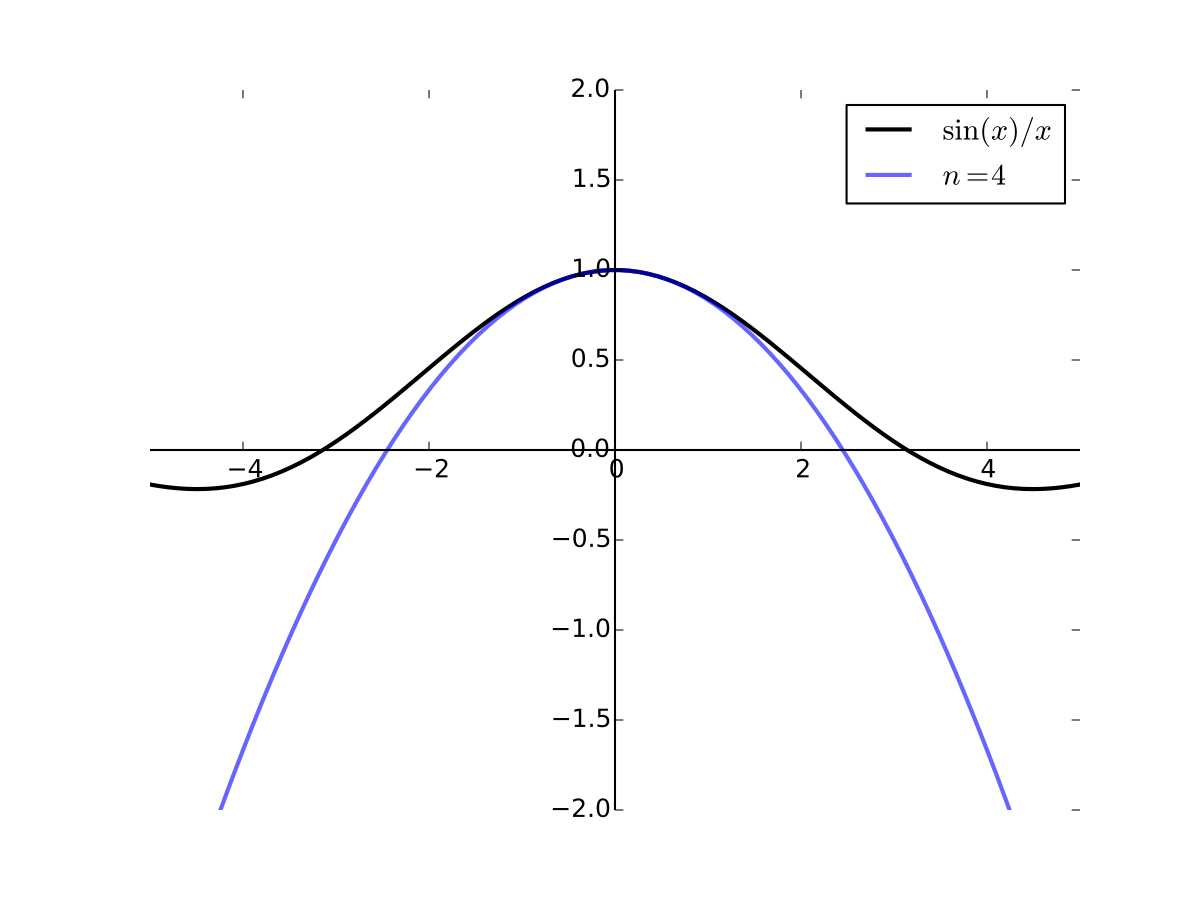
Fig. 33 4th order Taylor series for \(f(x) = \sin(x)/x\) at 0#
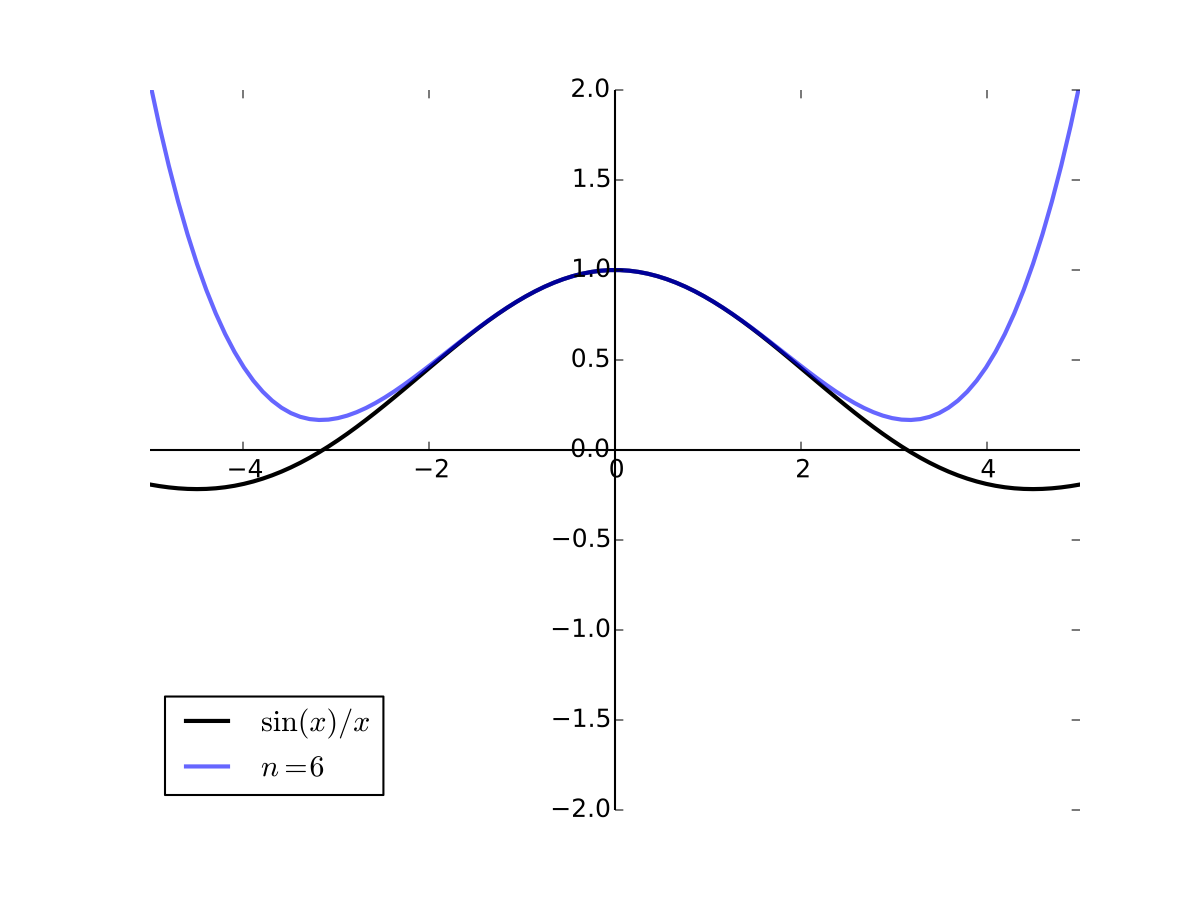
Fig. 34 6th order Taylor series for \(f(x) = \sin(x)/x\) at 0#
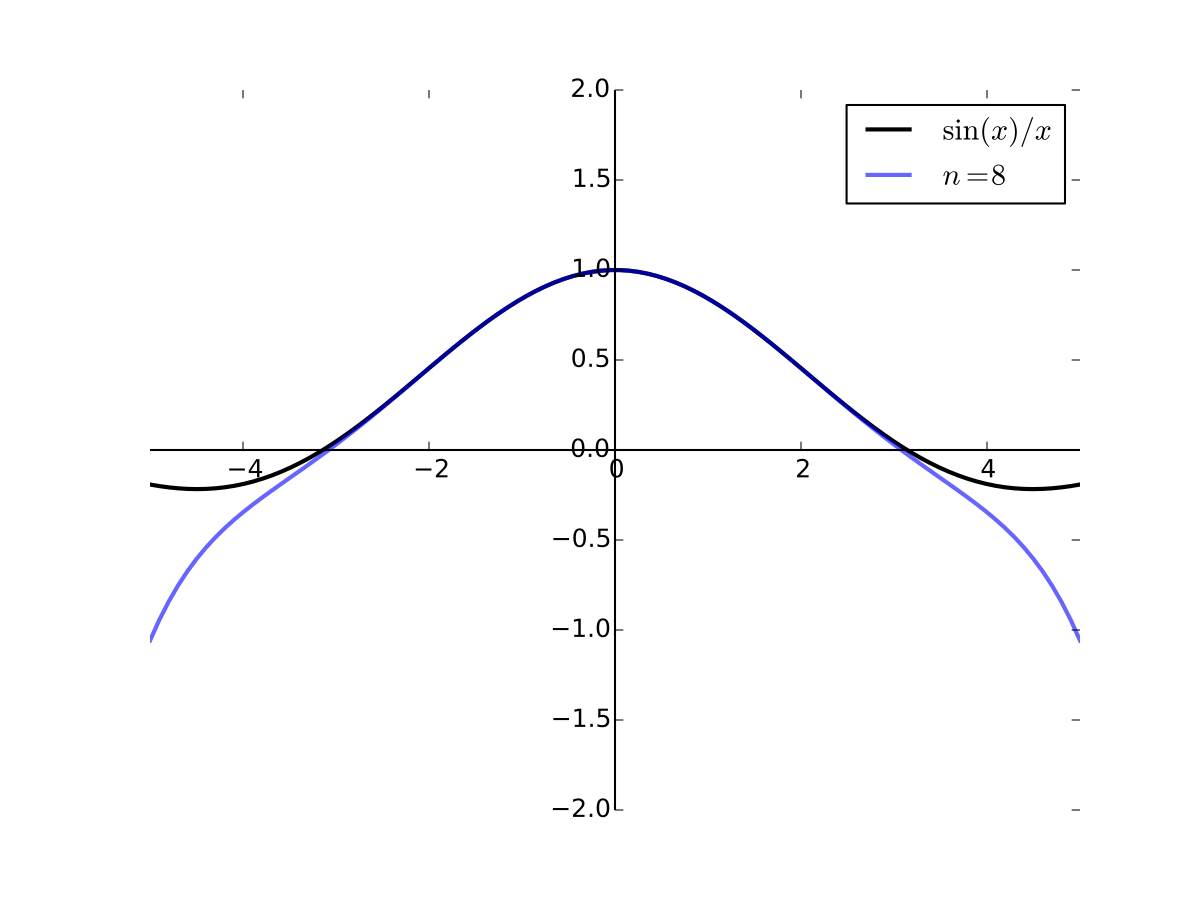
Fig. 35 8th order Taylor series for \(f(x) = \sin(x)/x\) at 0#
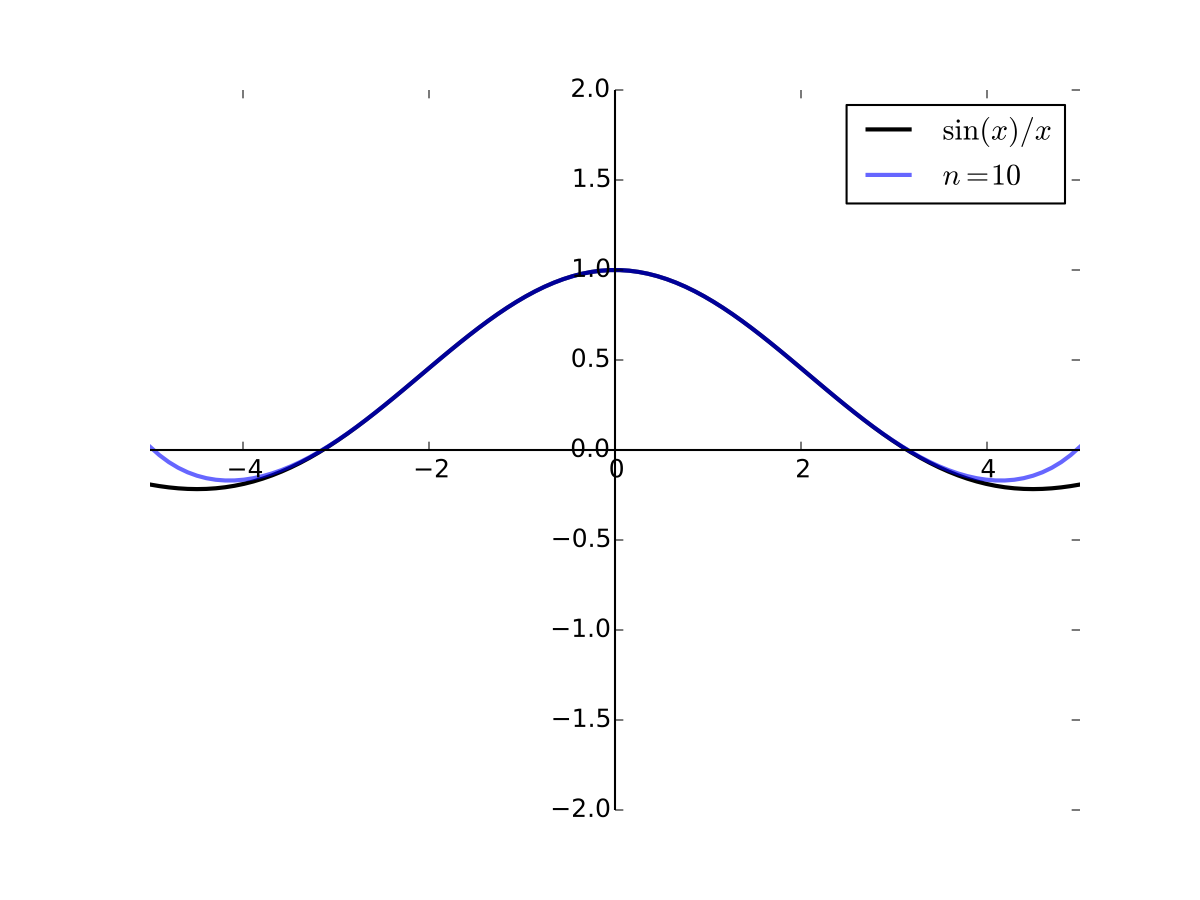
Fig. 36 10th order Taylor series for \(f(x) = \sin(x)/x\) at 0#
Analysis in \(\mathbb{R}^K\)#
Now we switch from studying points \(x \in \mathbb{R}\) to vectors \({\bf x} \in \mathbb{R}^K\)
Replace distance \(|x - y|\) with \(\| {\bf x} - {\bf y} \|\)
Many of the same results go through otherwise unchanged
We state the analogous results briefly since
You already have the intuition from \(\mathbb{R}\)
Similar arguments, just replacing \(|\cdot|\) with \(\| \cdot \|\)
We’ll spend longer on things that are different
Norm and distance#
Definition
The (Euclidean) norm of \({\bf x} \in \mathbb{R}^N\) is defined as
Interpretation:
\(\| {\bf x} \|\) represents the length of \({\bf x}\)
\(\| {\bf x} - {\bf y} \|\) represents distance between \({\bf x}\) and \({\bf y}\)
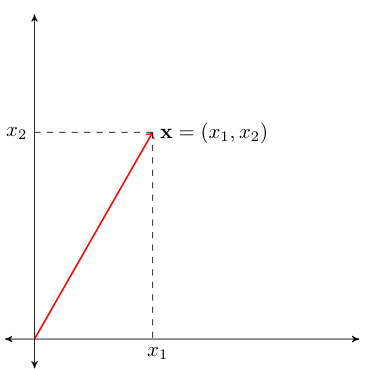
Fig. 37 Length of red line \(= \sqrt{x_1^2 + x_2^2} =: \|{\bf x}\|\)#
\(\| {\bf x} - {\bf y} \|\) represents distance between \({\bf x}\) and \({\bf y}\)

Fig. 38 Length of red line \(= \|{\bf x} - {\bf y}\|\)#
Fact
For any \(\alpha \in \mathbb{R}\) and any \({\bf x}, {\bf y} \in \mathbb{R}^N\), the following statements are true:
\(\| {\bf x} \| \geq 0\) and \(\| {\bf x} \| = 0\) if and only if \({\bf x} = {\bf 0}\)
\(\| \alpha {\bf x} \| = |\alpha| \| {\bf x} \|\)
\(\| {\bf x} + {\bf y} \| \leq \| {\bf x} \| + \| {\bf y} \|\) (triangle inequality)
\(| {\bf x}' {\bf y} | \leq \| {\bf x} \| \| {\bf y} \|\) (Cauchy-Schwarz inequality)
For example, let’s show that \(\| {\bf x} \| = 0 \iff {\bf x} = {\bf 0}\)
First let’s assume that \(\| {\bf x} \| = 0\) and show \({\bf x} = {\bf 0}\)
Since \(\| {\bf x} \| = 0\) we have \(\| {\bf x} \|^2 = 0\) and hence \(\sum_{n=1}^N x^2_n = 0\)
That is \(x_n = 0\) for all \(n\), or, equivalently, \({\bf x} = {\bf 0}\)
Next let’s assume that \({\bf x} = {\bf 0}\) and show \(\| {\bf x} \| = 0\)
This is immediate from the definition of the norm
Bounded sets and \(\epsilon\)-balls#
Definition
A set \(A \subset \mathbb{R}^K\) called bounded if
Remarks:
A generalization of the scalar definition
When \(K=1\), the norm \(\| \cdot \|\) reduces to \(|\cdot|\)
Fact
If \(A\) and \(B\) are bounded sets then so is \(C := A \cup B\)
Proof: Same as the scalar case — just replace \(|\cdot|\) with \(\| \cdot \|\)
Exercise: Check it
Definition
For \(\epsilon > 0\), the \(\epsilon\)-ball \(B_{\epsilon}({\bf a})\) around \({\bf a} \in \mathbb{R}^K\) is all \({\bf x} \in \mathbb{R}^K\) such that \(\|{\bf a} - {\bf x}\| < \epsilon\)

Fact
If \({\bf x}\) is in every \(\epsilon\)-ball around \({\bf a}\) then \({\bf x}={\bf a}\)
Fact
If \({\bf a} \ne {\bf b}\), then \(\exists \, \epsilon > 0\) such that \(B_\epsilon({\bf a}) \cap B_\epsilon({\bf b}) = \emptyset\)
Definition
A sequence \(\{{\bf x}_n\}\) in \(\mathbb{R}^K\) is a function from \(\mathbb{N}\) to \(\mathbb{R}^K\)
Definition
Sequence \(\{{\bf x}_n\}\) is said to converge to \({\bf a} \in \mathbb{R}^K\) if
We say: “\(\{{\bf x}_n\}\) is eventually in any \(\epsilon\)-neighborhood of \({\bf a}\)”
In this case \({\bf a}\) is called the limit of the sequence, and we write
Definition
We call \(\{ {\bf x}_n \}\) convergent if it converges to some limit in \(\mathbb{R}^K\)


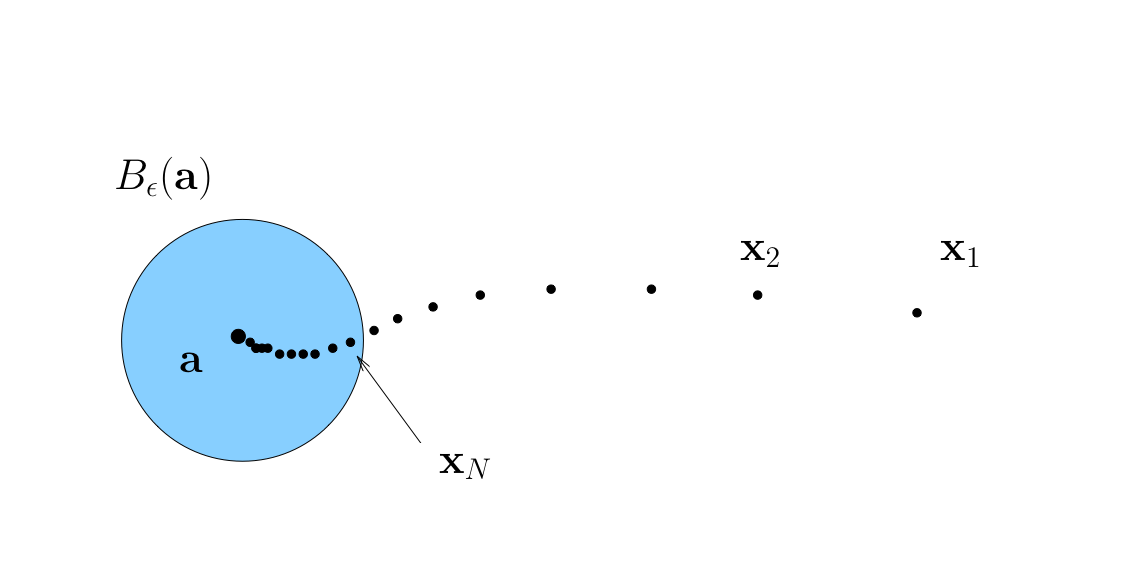
Vector vs Componentwise Convergence#
Fact
A sequence \(\{{\bf x}_n\}\) in \(\mathbb{R}^K\) converges to \({\bf a} \in \mathbb{R}^K\) if and only if each component sequence converges in \(\mathbb{R}\)
That is,
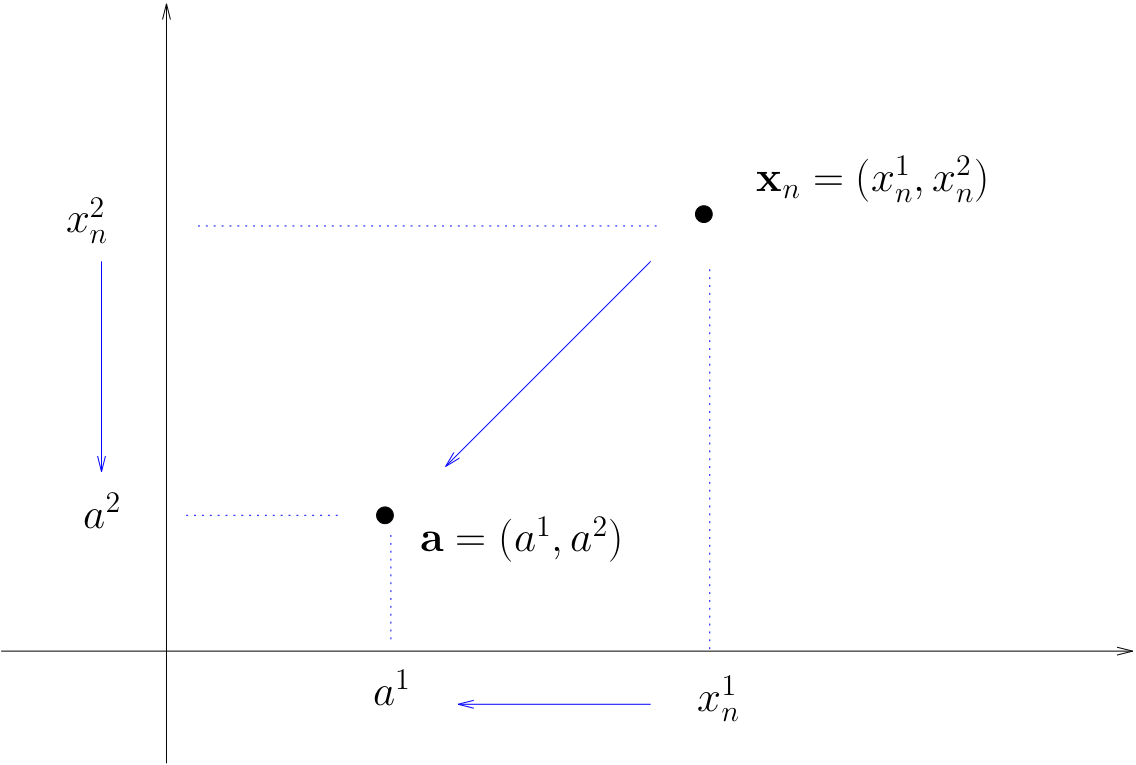
From Scalar to Vector Analysis#
More definitions analogous to scalar case:
Definition
A sequence \(\{{\bf x}_n\}\) is called Cauchy if
Definition
A sequence \(\{{\bf x}_{n_k} \}\) is called a subsequence of \(\{{\bf x}_n\}\) if
\(\{{\bf x}_{n_k} \}\) is a subset of \(\{{\bf x}_n\}\)
the indices \(n_k\) are strictly increasing
Fact
Analogous to the scalar case,
\({\bf x}_n \to {\bf a}\) in \(\mathbb{R}^K\) if and only if \(\|{\bf x}_n - {\bf a}\| \to 0\) in \(\mathbb{R}\)
If \({\bf x}_n \to {\bf x}\) and \({\bf y}_n \to {\bf y}\) then \({\bf x}_n + {\bf y}_n \to {\bf x} + {\bf y}\)
If \({\bf x}_n \to {\bf x}\) and \(\alpha \in \mathbb{R}\) then \(\alpha {\bf x}_n \to \alpha {\bf x}\)
If \({\bf x}_n \to {\bf x}\) and \({\bf z} \in \mathbb{R}^K\) then \({\bf z}' {\bf x}_n \to {\bf z}' {\bf x}\)
Each sequence in \(\mathbb{R}^K\) has at most one limit
Every convergent sequence in \(\mathbb{R}^K\) is bounded
Every convergent sequence in \(\mathbb{R}^K\) is Cauchy
Every Cauchy sequence in \(\mathbb{R}^K\) is convergent
Exercise: Adapt proofs given for the scalar case to these results
Example
Let’s check that
Proof
\({\bf x}_n \to {\bf a}\) in \(\mathbb{R}^K\) means that
\(\|{\bf x}_n - {\bf a}\| \to 0\) in \(\mathbb{R}\) means that
Obviously equivalent
Reminder — these facts are more general than scalar ones!
True for any finite \(K\)
So true for \(K = 1\)
This recovers the corresponding scalar fact
You can forget the scalar fact if you remember the vector one
Fact
If \(\{ {\bf x}_n \}\) converges to \({\bf x}\) in \(\mathbb{R}^K\), then every subsequence of \(\{{\bf x}_n\}\) also converges to \({\bf x}\)
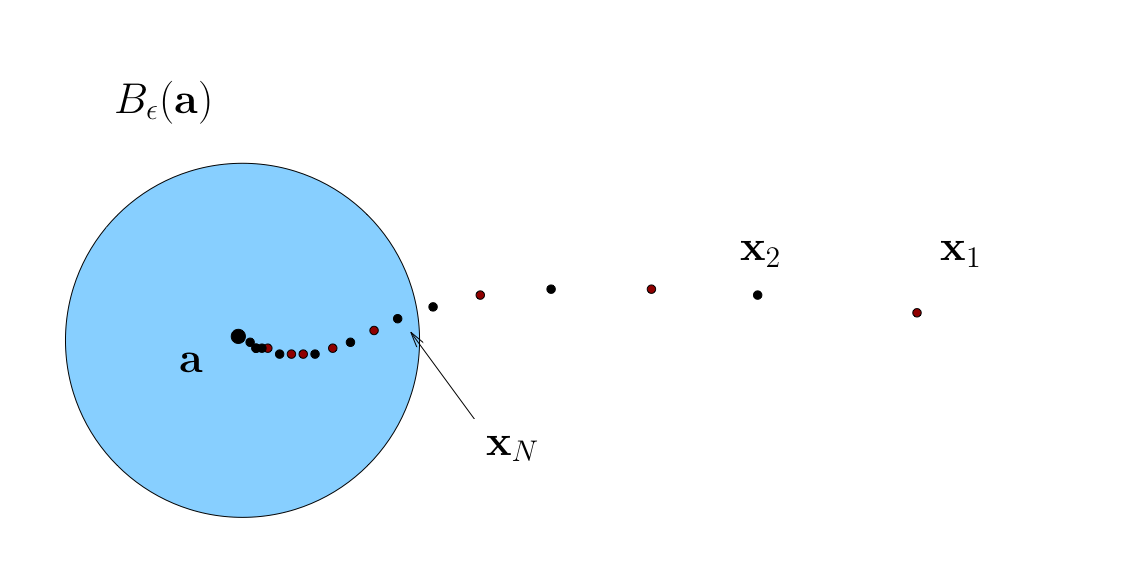
Fig. 39 Convergence of subsequences#
Infinite Sums in \(\mathbb{R}^K\)#
Analogous to the scalar case, an infinite sum in \(\mathbb{R}^K\) is the limit of the partial sum
Definition
If \(\{{\bf x}_n\}\) is a sequence in \(\mathbb{R}^K\), then
In other words,
Open and Closed Sets#
Let \(G \subset \mathbb{R}^K\)
Definition
We call \({\bf x} \in G\) interior to \(G\) if \(\exists \; \epsilon > 0\) with \(B_\epsilon({\bf x}) \subset G\)
Loosely speaking, interior means “not on the boundary”

Example
If \(G = (a, b)\) for some \(a < b\), then any \(x \in (a, b)\) is interior

Proof
Fix any \(a < b\) and any \(x \in (a, b)\)
Let \(\epsilon := \min\{x - a, b - x\}\)
If \(y \in B_\epsilon(x)\) then \(y < b\) because
Exercise: Show \(y \in B_\epsilon(x) \implies y > a\)
Example
If \(G = [-1, 1]\), then \(1\) is not interior

Intuitively, any \(\epsilon\)-ball centered on \(1\) will contain points \(> 1\)
More formally, pick any \(\epsilon > 0\) and consider \(B_\epsilon(1)\)
There exists a \(y \in B_\epsilon(1)\) such that \(y \notin [-1, 1]\)
For example, consider the point \(y := 1 + \epsilon/2\)
Exercise: Check this point: lies in \(B_\epsilon(1)\) but not in \([-1, 1]\)
Definition
A set \(G\subset \mathbb{R}^K\) is called open if all of its points are interior
Example
Open sets:
any “open” interval \((a,b) \subset \mathbb{R}\), since we showed all points are interior
any “open” ball \(B_\epsilon({\bf a}) = {\bf x} \in \mathbb{R}^K : \|{\bf x} - {\bf a} \| < \epsilon\)
\(\mathbb{R}^K\) itself
Example
Sets that are not open
\((a,b]\) because \(b\) is not interior
\([a,b)\) because \(a\) is not interior
Closed Sets#
Definition
A set \(F \subset \mathbb{R}^K\) is called closed if every convergent sequence in \(F\) converges to a point in \(F\)
Rephrased: If \(\{{\bf x}_n\} \subset F\) and \({\bf x}_n \to {\bf x}\) for some \({\bf x} \in \mathbb{R}^K\), then \({\bf x} \in F\)
Example
All of \(\mathbb{R}^K\) is closed because every sequence converging to a point in \(\mathbb{R}^K\) converges to a point in \(\mathbb{R}^K\)… right?
Example
If \((-1, 1) \subset \mathbb{R}\) is not closed
Proof
True because
\(x_n := 1-1/n\) is a sequence in \((-1, 1)\) converging to \(1\),
and yet \(1 \notin (-1, 1)\)
Example
If \(F = [a, b] \subset \mathbb{R}\) then \(F\) is closed in \(\mathbb{R}\)
Proof
Take any sequence \(\{x_n\}\) such that
\(x_n \in F\) for all \(n\)
\(x_n \to x\) for some \(x \in \mathbb{R}\)
We claim that \(x \in F\)
Recall that (weak) inequalities are preserved under limits:
\(x_n \leq b\) for all \(n\) and \(x_n \to x\), so \(x \leq b\)
\(x_n \geq a\) for all \(n\) and \(x_n \to x\), so \(x \geq a\)
therefore \(x \in [a, b] =: F\)
Example
Any “hyperplane” of the form
is closed
Proof
Fix \({\bf a} \in \mathbb{R}^K\) and \(c \in \mathbb{R}\) and let \(H\) be as above
Let \(\{{\bf x}_n\} \subset H\) with \({\bf x}_n \to {\bf x} \in \mathbb{R}^K\)
We claim that \({\bf x} \in H\)
Since \({\bf x}_n \in H\) and \({\bf x}_n \to {\bf x}\) we have
Properties of Open and Closed Sets#
Fact
\(G \subset \mathbb{R}^K\) is open \(\iff \; G^c\) is closed
Proof
\(\implies\)
First prove necessity
Pick any \(G\) and let \(F := G^c\)
Suppose to the contrary that \(G\) is open but \(F\) is not closed, so
\(\exists\) a sequence \(\{{\bf x}_n\} \subset F\) with limit \({\bf x} \notin F\)
Then \({\bf x} \in G\), and since \(G\) open, \(\exists \, \epsilon > 0\) such that \(B_\epsilon({\bf x}) \subset G\)
Since \({\bf x}_n \to {\bf x}\) we can choose an \(N \in \mathbb{N}\) with \({\bf x}_N \in B_\epsilon({\bf x})\)
This contradicts \({\bf x}_n \in F\) for all \(n\)
\(\Longleftarrow\)
Next prove sufficiency
Pick any closed \(F\) and let \(G := F^c\), need to prove that \(G\) is open
Suppose to the contrary that \(G\) is not open
Then exists some non-interior \({\bf x} \in G\), that is no \(\epsilon\)-ball around \(x\) lies entirely in \(G\)
Then it is possible to find a sequence \(\{{\bf x}_n\}\) which converges to \(x \in G\), but every element of which lies in the \(B_{1/n}({\bf x}) \cap F\)
This contradicts the fact that \(F\) is closed
Example
Any singleton \(\{ {\bf x} \} \subset \mathbb{R}^K\) is closed
Proof
Let’s prove this by showing that \(\{{\bf x}\}^c\) is open
Pick any \({\bf y} \in \{{\bf x}\}^c\)
We claim that \({\bf y}\) is interior to \(\{{\bf x}\}^c\)
Since \({\bf y} \in \{{\bf x}\}^c\) it must be that \({\bf y} \ne {\bf x}\)
Therefore, exists \(\epsilon > 0\) such that \(B_\epsilon({\bf y}) \cap B_\epsilon({\bf x}) = \emptyset\)
In particular, \({\bf x} \notin B_\epsilon({\bf y})\), and hence \(B_\epsilon({\bf y}) \subset \{{\bf x}\}^c\)
Therefore \({\bf y}\) is interior as claimed
Since \({\bf y}\) was arbitrary it follows that \(\{{\bf x}\}^c\) is open and \(\{{\bf x}\}\) is closed
Fact
Any union of open sets is open
Any intersection of closed sets is closed
Proof
Proof of first fact:
Let \(G := \cup_{\lambda \in \Lambda} G_\lambda\), where each \(G_\lambda\) is open
We claim that any given \({\bf x} \in G\) is interior to \(G\)
Pick any \({\bf x} \in G\)
By definition, \({\bf x} \in G_\lambda\) for some \(\lambda\)
Since \(G_\lambda\) is open, \(\exists \, \epsilon > 0\) such that \(B_\epsilon({\bf x}) \subset G_\lambda\)
But \(G_\lambda \subset G\), so \(B_\epsilon({\bf x}) \subset G\) also holds
In other words, \({\bf x}\) is interior to \(G\)
But be careful:
An infinite intersection of open sets is not necessarily open
An infinite union of closed sets is not necessarily closed
For example, if \(G_n := (-1/n, 1/n)\), then \(\cap_{n \in \mathbb{N}} G_n = \{0\} \)
To see this, suppose that \(x \in \cap_n G_n\)
Then
Therefore \(x = 0\), and hence \(x \in \{0\}\)
On the other hand, if \(x \in \{0\}\) then \(x \in \cap_n G_n\)
Fact
If \(A\) is closed and bounded then every sequence in \(A\) has a subsequence which converges to a point of \(A\)
Take any sequence \(\{{\bf x}_n\}\) contained in \(A\)
Since \(A\) is bounded, \(\{{\bf x}_n\}\) is bounded
Therefore it has a convergent subsequence
Since the subsequence is also contained in \(A\), and \(A\) is closed, the limit must lie in \(A\).
Definition
Bounded and closed sets are called compact sets or compacts
Continuity#
One of the most fundamental properties of functions
Related to existence of
optima
roots
fixed points
etc
as well as a variety of other useful concepts
Definition
A function \(F\) is called bounded if its range is a bounded set.
Fact
If \(F\) and \(G\) are bounded, then so are \(F+G\), \(F \cdot G\) and \(\alpha F\) for any finite \(\alpha\)
Proof
Proof for the case \(F + G\):
Let \(F\) and \(G\) be bounded functions
\(\exists\) \(M_F\) and \(M_G\) s.t. \(\| F({\bf x}) \| \leq M_F\) and \(\| G({\bf x}) \| \leq M_G\) for all \({\bf x}\)
Fix any \({\bf x}\) and let \(M := M_F + M_G\)
Applying the triangle inequality gives
Since \({\bf x}\) was arbitrary this bound holds for all \({\bf x}\)
Let \(F \colon A \to \mathbb{R}^J\) where \(A\) is a subset of \(\mathbb{R}^K\)
Definition
\(F\) is called continuous at \({\bf x} \in A\) if as \(n \to \infty\)
Requires that
\(F({\bf x}_n)\) converges for each choice of \({\bf x}_n \to {\bf x}\),
The limit is always the same, and that limit is \(F({\bf x})\)
Definition
\(F\) is called continuous if it is continuous at every \({\bf x} \in A\)
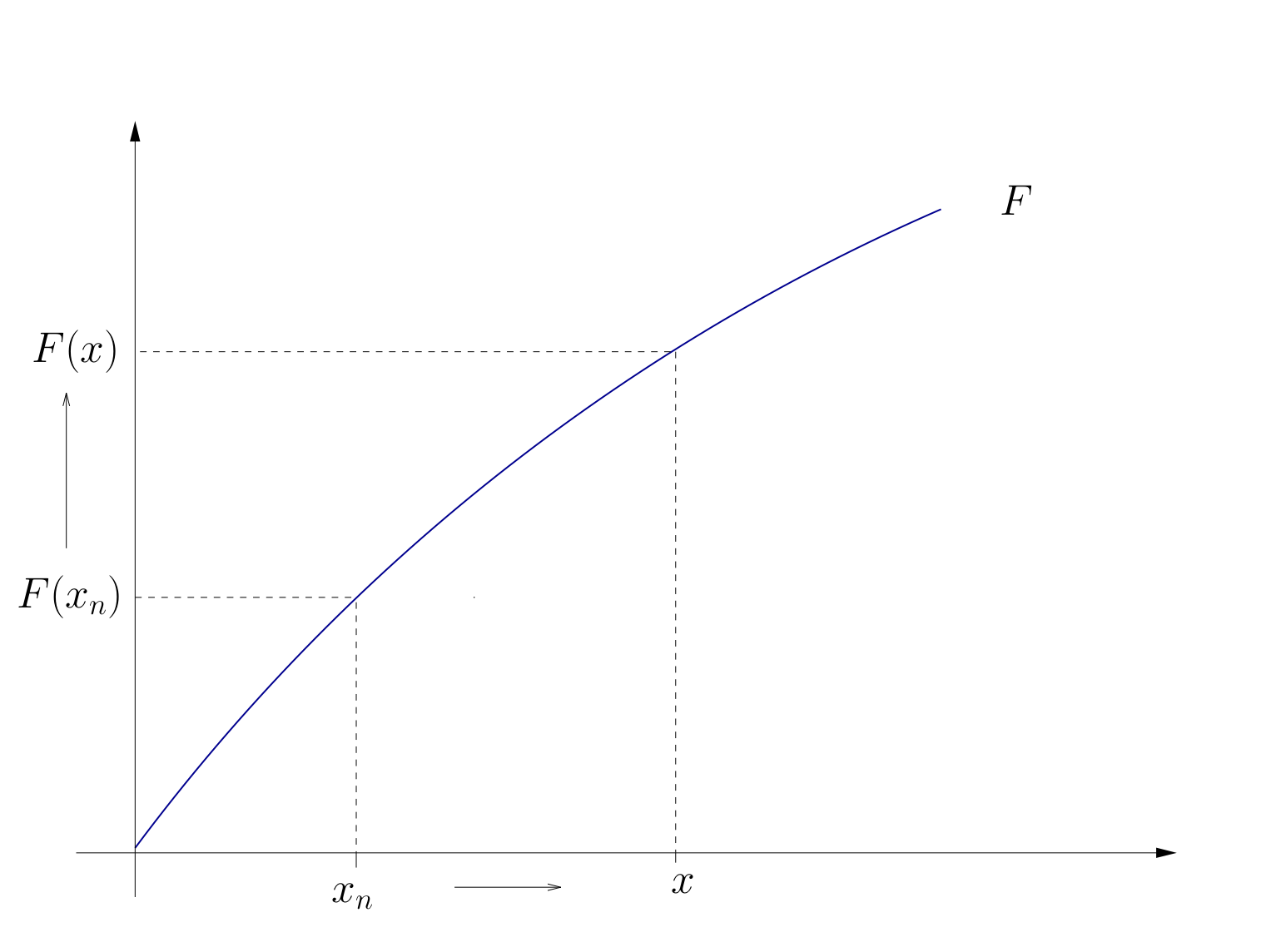
Fig. 40 Continuity#

Fig. 41 Discontinuity at \(x\)#
Example
Let \({\bf A}\) be an \(J \times K\) matrix and let \(F({\bf x}) = {\bf A} {\bf x}\)
The function \(F\) is continuous at every \({\bf x} \in \mathbb{R}^K\)
To see this take
any \({\bf x} \in \mathbb{R}^K\)
any \({\bf x}_n \to {\bf x}\)
By the definition of the matrix norm \(\| {\bf A} \|\), we have
Exercise: Exactly what rules are we using here?
Fact
If \(f \colon \mathbb{R} \to \mathbb{R}\) is differentiable at \(x\), then \(f\) is continuous at \(x\)
Fact
Some functions known to be continuous on their domains:
\(x \mapsto x^\alpha\)
\(x \mapsto |x|\)
\(x \mapsto \log(x)\)
\(x \mapsto \exp(x)\)
\(x \mapsto \sin(x)\)
\(x \mapsto \cos(x)\)
Example
Discontinuous at zero: \(x \mapsto \mathbb{1}\{x > 0\}\).
Fact
Let \(F\) and \(G\) be functions and let \(\alpha \in \mathbb{R}\)
If \(F\) and \(G\) are continuous at \({\bf x}\) then so is \(F + G\), where
If \(F\) is continuous at \({\bf x}\) then so is \(\alpha F\), where
If \(F\) and \(G\) are continuous at \({\bf x}\) and real valued then so is \(FG\), where
In the latter case, if in addition \(G({\bf x}) \ne 0\), then \(F/G\) is also continuous.
As a result, set of continuous functions is “closed” under elementary arithmetic operations
Example
The function \(F \colon \mathbb{R} \to \mathbb{R}\) defined by
is continuous
Proof
Just repeatedly apply the rules on the previous slide
Let’s just check that
Let \(F\) and \(G\) be continuous at \({\bf x}\)
Pick any \({\bf x}_n \to {\bf x}\)
We claim that \(F({\bf x}_n) + G({\bf x}_n) \to F({\bf x}) + G({\bf x})\)
By assumption, \(F({\bf x}_n) \to F({\bf x})\) and \(G({\bf x}_n) \to G({\bf x})\)
From this and the triangle inequality we get
Extra material#
Watch excellent video by Grant Sanderson (3blue1brown) on limits, and continue onto his whole amazing series on calculus
